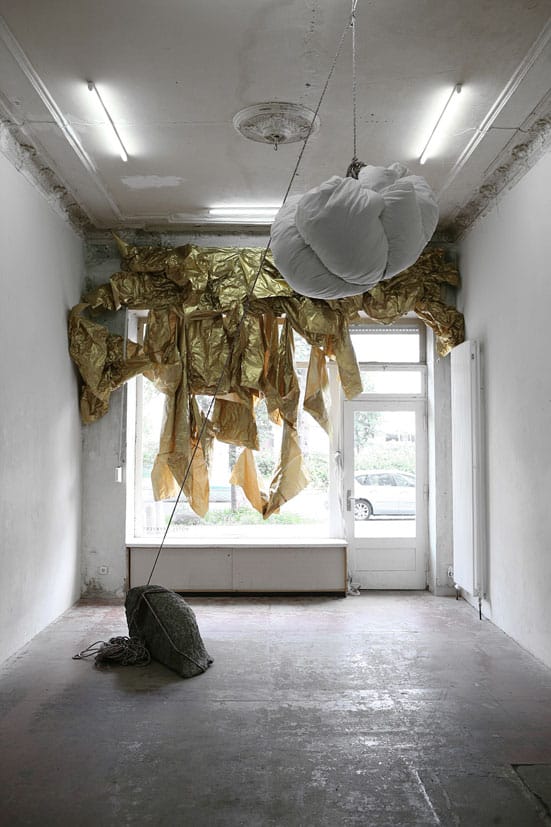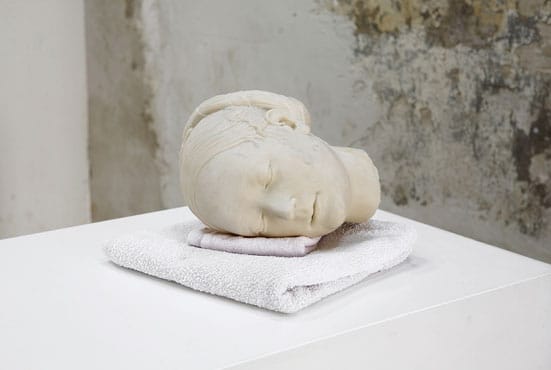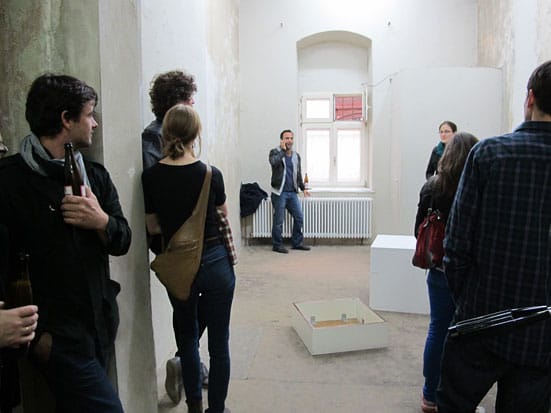AL: Please tell us something about Hotel Paravent.
MB/AL/TEF: Hotel Paravent is a project hotel located in the exhibition space Tête throughout June 2012. It operates as in a sleep laboratory, the essential needs of the hotel guests/exhibition visitors for regeneration are met by the objects on display.
The hotel room is furnished with hybrids of pure idea and actual necessity - a dissolving screen, a suspended bed, a museum plinth turned into a shower. A night-long dialogue emerges through performative moments of usage as the guest gets undressed, lies down, sleeps, wakes up, washes, and gets dressed. Focusing on minimal requirements - privacy, a place for recuperation, facilities to wash - HOTEL PARAVENT offers an elemental way of staying overnight.
Through the use and the transformation of the exhibition space Tête, Hotel Paravent invites the guest to reflect about art through the hotel context. Our project can be read as a metaphor: through usage the requisitioning /comfort/ art and its context and also the value of an art work.
AL: Who runs/curates it?
MB/AL/TEF: We are three artists, Manon Bellet/ Tatiana Echeverri Fernandez/ Antonia Low
Our work deals with, and requestions, public space/ private space, environment, immateriality, temporality and spatiality. We decided, when we started thinking about where this project could go, to invite other artists to be part of the project. We wanted other artists to engage with the idea and also make room for other kinds of interpretation and we wanted them to lead the project in other directions which link with the hotel project but also touch on other ideas. It was to generate discussions around what we can expect from an exhibition and how it links with our understanding of needs.
We wanted to offer interesting artists a place to stay, like a residency. The invited artists were asked to invite visitors to come to their hotel room.
We recently had an exhibition show titled 'presence/absence' curated by Tatiana Echeverri Fernandez. In it actors played the roles assigned them by the artist in the exhibition and an interesting shift of authorship took place.
The hotel itself represents that shift. The bed is a bed when it is a bed and the work can be seen as a piece of work when it is not being used as a bed. So does sleeping in it undermine the artistically quality of it? This is an interesting thing to experience. You start to question that fine line and you can just see yourself crossing that line. You will know it is there when you just want to sleep.
We are doing the hotel in the project space Tete, where artist have come together to use the rooms independently from each other for a month.
AL: What does the overnight guest experience?
MB/AL/TEF: What will they rethink and reconsider?
Survival/basic exhibition = basic hotel
Getting the visitor involved instead of serving his wish for comfort.
The bed for example has to been worked for. You can sleep in the piece "tired stone" but there is no rest without work done beforehand. You have to use your skills, you have to touch a rough rope and untie the stone.
Freeing the stone will get you the rest you need.
The screen "Jalousie d'hier" will protect you only symbolically from the outside. Through the wind-machine hidden inside it it brings the outside inside. You can still be on the street with your eyes and lie in the bed about to sleep, watching passersby, the beautiful green of the lit trees coming trough the shapes of the screen and watching the headlights of cars passing by. However you will also experience your private space being exposed to the outside.
When you want to shower you are required to go and get the water in a cast of the head of Princess of Naples - the original head is on display in the Bode Museum, Berlin. This references a time when one would get a jug of water to wash oneself. This time, inside a plinth, originally used in the Berlinerische Galerie, now repurposed as a shower basin. "Prinzessin von Neapel gereicht zum Bade" is the title of the shower.
This idea of using an artwork turns the exhibition visitor/hotel guest into the performing subject of the show - a show is made possible for a hotel guest to meet his needs.
AL: Are the artworks permanent installations or temporary events or both?
MB/AL/TEF: There are different ways to use the hotel: demonstrating a shift of authorship: The shift between hotel and exhibition space; Project space > a hotel > used for events> residency
The guest represents the implementation of the whole idea
Temporary events, their functions and use are different every time
AL: How does one book into Hotel Paravent?
MB/AL/TEF: You just go to our website: hotelparavent.info. Under 'booking' you find all the information you need.
AL: What do you have planned for the future?
MB/AL/TEF: We like to think of the hotel as an ongoing project, the works can go to other exhibition spaces, museums and even into collections. It is both an installation and a concept.
For us this is an experiment and we are open to many possibilities and experiences. We don't know yet where this will lead us but we feel it has a lot of potential. Of course the possibility is there to continue the hotel in different cities and different contexts. This could be interesting, as it would take it further and disenfranchise it. For example: to think about where a hotel is needed and where it is not. We particularly like the idea of having a hotel where you don't need one or where you would not expect one, as a next project.
We are not interested in an "art hotel" where art is the decoration in the hotel.
There are a lot of art hotels out there and the idea itself is really off-putting somehow. We are not interested in using the artworks as decoration; we want Hotel Paravent to be radical in the way it operates. This is why it is important to cross the line of only suggesting usage and constantly experiencing of shifts of borders. I think visitors see this all the time, both the actual overnight guests and also the visitors of our events.
People have suggested that we do it during artfairs, like in Miami but we are not into that idea of expected exclusivity in such a highly-charged environment. The exclusivity happens on a completely different level, on a personal one.
We are doing Hotel Paravent when everywhere; mega-events are happening like Art Basel, Manifesta or the opening of the Documenta. We are running it during The Bienale in Berlin, which is not meant to be on a personal level but on a political one...
I think we are political on a personal level.
About the artists
Moving between the imaginary boundaries of space, Manon Bellet operates within a landscape of uncertainty, on a temporal layer of transition points. Drawn by light, shadow and heat, the borderline marks the ambiguous trace of a discrete disappearing. With her installation she calls to our attention that all borders are accidental. In a topographical setting for spatial and temporal projections, each point within a secure space becomes apparent just as an inventory of its environment, which repeats itself.
In Tatiana Echeverri Fernandez's installations and sculptures raw materials are juxtaposed with found industrial objects. This "collision" of materials and the resulting transformation of content create friction suggesting new levels of abstraction between function, dysfunction and object. Found objects, fragments and situations are taken from their everyday context to indicate new imaginative spaces for further perspectives.
Antonia Low takes the means of expression in her art from its interaction with the environment, as a consciously applied instrument. Her installations make reference to spatial circumstances. Through re-evaluations, disclosures, and allocations, Low makes a central theme of their different aspects and finds new points of emphasis. She pursues the overlapping of different layers of temporality and spatiality and brings the transitory substance of spaces to light.
Adrian Lee

Front : “Tired Stone” 2012
inflatable bed, bedding, rope,
290KG granite stone
Tatiana Echeverri Fernandez,
back : “Jalousie d’hier” 2012
golden silk paper, ventilator
Manon Bellet
photographer: Tatiana Echeverri Fernandez

“Prinzessin von Neapel gereicht zum Bade” 2012
plinth, replica of Prinzessin of Neapel, epoxy,water
Antonia Low
photographer: Tatiana Echeverri Fernandez

Adrian Lee and Patrick Khatami
“Conversation Piece” 2012
from the show Presence/Absence
Photographer: Jaro Straub

Elly Clark and Lacey Haynes
"A Slide Show by Lacey Haynes" 2012
from the show Presence/Absence
Photographer: Jaro Straub